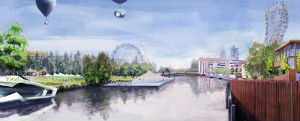A vision for a smart and sustainable Reading in 2050
19 October 2017

A new vision for the future of Reading in 2050 has been launched at the refurbished Thames Lido in the heart of the town by Reading UK, design and planning consultancy Barton Willmore and the University of Reading.
Reading 2050 outlines an ambitious, smart and sustainable future for Reading, putting green technology, culture and diversity and Reading’s rivers and parks at the heart of its future development.
To accompany the launch, the University's School of Construction Management and Engineering have also launched a public lecture series bringing together experts across academic disciplines, from sustainable energy to history and heritage, to discuss and debate how Reading should evolve to a smarter and more sustainable future by 2050.
See how Reading could look in 2050 in this video
A smarter and more sustainable Reading
Professor Tim Dixon, University of Reading, said: “Many cities in the UK and around the world are developing long-term visions that reflect shared expectations about a sustainable future. A city vision helps us understand how we can work together and mobilise knowledge and resources to tackle longer term environmental change.
“The Reading 2050 vision is important because it is founded on the principle of both smart and sustainable thinking, taking us beyond short-term fixes, and looking at tangible, longer term solutions to the main socio-economic and environmental challenges Reading will face over the next 30 years and beyond.”
A series of workshops, exhibitions and consultations with a wide cross section of stakeholder groups, including businesses, Reading Borough Council and Reading residents, has helped shape the vision. This seeks to create a smart and sustainable long-term future for Reading and its current and future residents.
"Our vision for Reading in 2050 is one which celebrates and builds on existing strengths and provides a shared ambition which brings benefit to all" - Nigel Horton-Baker, Executive Director Reading UK
Three core themes, underpinned by Reading’s existing strengths and natural assets, emerged during the consultation process as the embodiment of a smart and sustainable Reading in 2050:
Green Tech City - building on Reading’s established technological business base to ensure Reading performs strongly in a globally competitive economy.
A picture of Green Tech Reading in 2050: from the provision of the greenest accommodation possible to the latest sustainable transport networks creating an uncongested city centre; the Internet of Things opening up new markets, revolutionising our homes and the way we live and learn; retro-fitting of existing buildings and iconic new architecture; a University presence in the city centre that tests cutting-edge ideas; showcasing innovation among business; renewable energy programmes; invest in our green strengths.
A headline from 2050? - ‘Reading becomes the first UK 100% renewable, self-powered city’
A City of Rivers and Parks - embracing Reading’s waterways and green spaces to improve the quality of life and providing a vital lung for the city
A picture of Reading City of Rivers and Parks in 2050: new recreational spaces and sporting facilities; diverse waterside living opportunities and waterway strategies for food production; new river transport; renewable energy from waterways; making our buildings green spaces in themselves; better use of green space for education; community ownership of open spaces for events.
A headline from 2050? – ‘Reading’s new IDR park to be finish of Tour of Britain 2050’
A City of Culture and Diversity - Reading’s rich heritage and strong cultural base becomes a fundamental part of the city’s make-up. Reading in 2050 is a cultural destination in its own right as well as providing a great lifestyle for our current and future communities.
A picture of Reading City of Culture and Diversity in 2050: Reading delivers arts and culture to people of all ages and backgrounds; a 365-day-a-year festival city with vibrant public spaces and community celebrations; the city boasts modern interpretation of Reading’s heritage, community and creative hubs; riverside festivals; technology sits at the heart of cultural programmes; a new theatre; public art city wide; arts and humanities support the city’s well- being; independent retail districts; coordinated leisure visitor offer.
A headline from 2050? – ‘Reading named the UK’s friendliest city’
"It’s fantastic to secure such high levels of engagement from the community who have become really enthused about what Reading could look like" - Kim Cohen, Partner at Barton Willmore
Nigel Horton-Baker, Executive Director Reading UK, said: “Reading today is a defacto city with a powerful economy, vibrant retail and leisure centre, established cultural scene and a rich, diverse heritage. For many, economic success has brought with it a high quality of life and attractive work life balance.
"However, this success also presents a range of socio-economic and environmental challenges, not least in terms of equality of opportunity for everyone. Our vision for Reading in 2050 is one which celebrates and builds on existing strengths and provides a shared ambition which brings benefit to all.”
Kim Cohen, Partner at Barton Willmore , said: “The vision for Reading 2050 and the shaping of the City has been driven by more than 21,000 members of the thriving local and business community who live, work and play here. They have shared their ideas of how Reading can have a real sense of place and identity that is culturally diverse, supports green tech and celebrates its array of watercourses and open space.
"It’s fantastic to secure such high levels of engagement from the community who have become really enthused about what Reading could look like if we are ambitious and collaborate.”
The interactive digital Reading 2050 Vision is available at www.reading2050.co.uk Get involved at www.facebook.com/reading2050 or via Twitter at #Reading2050.
Image credit: Barton Willmore Architects
